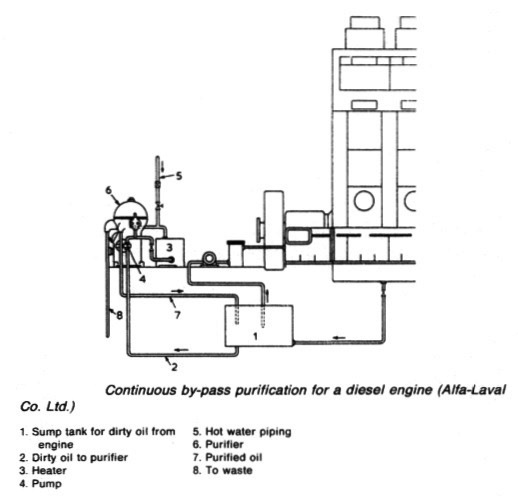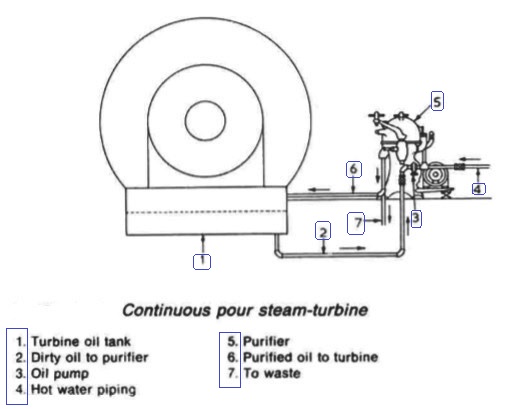
Home page||Machinery service system||
Lubricating oil and treatment- procedure for motor ships
Mineral oils for lubrication are, like fuel, derived from crude during refinery processes. Basic stocks are blended to make lubricants with the desired properties and correct viscosity for particular duties.
Additives are used to enhance the general properties of the oil and these include oxidation and corrosion inhibitors, anti-corrosion and rust prevention additives, foam inhibitors and viscosity index (VI) improvers. The latter lowers the rate of change of viscosity with temperature. Basic mineral oil is the term commonly used for oils with the additives mentioned above.
These additives enhance the general properties of the oil, HD or detergent type oils are derived in the same way as basic mineral oils by blending and the use of additives to enhance general properties but additional additives are used to confer special properties. Thus detergent-dispersant ability and the use of alkaline additives make these oils suitable for use in diesel engines
Detergent type or HD lubricating oils
The main function of detergent-dispersant additives in a lubricating oil is to pick up and hold solids in suspension. This capability can be applied to other additives such as the acid neutralizing alkaline compounds as well as solid contaminants. Thus detergent oils hold contaminants in suspension and prevent both their agglomeration and deposition in the engine. This function reduces ring sticking, wear of piston rings and cylinder liners, and generally improves the cleanliness of the engine. Other functions include reduction of lacquer formation, corrosion and oil oxidation.
These functions are achieved by the formation of an envelope of detergent oil round each particle of solid contaminant. This envelope prevents coagulation and deposition and keeps the solids in suspension in the oil. In engines of the trunk piston type with a combined lubrication system for bearings and cylinders, in addition to the deposition of the products of
incomplete combustion which occurs on pistons, piston rings and grooves, some of these products can be carried down into the crankcase, contaminating the crankcase oil with acid products and causing deposit build up on surfaces and in oil lines.
Detergent oils are, therefore, widely used in this type of engine, The detergent additives used today are, in most cases, completely soluble in the oil. There is a tendency for the detergent to be water soluble, so that an emulsion may be formed particularly if a water-washing system is used while purifying.
Manufacturers of centrifuges have carried out a considerable amount of research work in conjunction with the oil companies on the centrifuging of basic mineral and detergent lubricating oils using three different methods of centrifuging. These are purification, clarification and purification with water washing.
The following is a summary of the findings and recommendations based on the results which were obtained. When operating either as a purifier (with or without water washing) or as a clarifier, all particles of the order of 3—5 microns and upwards are completely extracted, and when such particles are of high specific gravity, for example iron oxide, very much smaller particles are removed. The average size of solid particles left in the oil after centrifuging are of the order of only 1—2 microns. (One micron is a thousandth part of a millimetre.) Particles left in the oil are not in general of sufficient size to penetrate any oil film in the lubricating oil system.
A centrifuge should be operated only with the bowl set up as a purifier, when the rate of contamination of the lubricating oil by water is likely to exceed the water-holding capacity of the centrifuge bowl between normal bowl cleanings. When the rate of water contamination is negligible the centrifuge can be operated with the bowl set up as a clarifier. No sealing water is then required and this reduces the risk of emulsification of HD oils.
Any water separated will be retained in the dirt-holding space of the bowl. For basic mineral oils in good condition, purification with water washing can be employed to remove water soluble acids from the oil, in addition to solid and water contaminants. This method may be acceptable for some detergent lubricating oils but it should not be used without reference to the oil supplier. 
Figure 1: Continuous bypass systems for diesel engine
Batch and continuous lubricating systems
For small or medium units without a circulatory lubricating system, the oil can be treated on the batch system. As large a quantity of oil as possible is pumped from the engine or system to a heating tank. The heated oil is passed through the purifier and back to the sump.
For removing soluble sludge, a system combining the batch and continuous systems is effective. The oil is pumped to a tank, where it is allowed to settle for 24 or 48 hours. The oil may be heated by steam coils and basic mineral oils in good condition may be water washed. After settling sludge is drawn off, and
the oil is run through the purifier and back to the tank on a continuous system before being finally delivered back through the purifier to the sump.

Figure 2: Continuous pour steam turbine
Summarized below some of the basic procedure of machinery service systems and equipment :
- Marine air compressor
A single stage compressor used to provide air at the high pressures required for diesel engine starting, would unfortunately generate compression temperatures of a level similar to those in a diesel. Such heat would be sufficient to ignite vaporized oil in the same way as in a compression-ignition engine. The heat produced in a single stage of compression would also be wasteful of energy.....
- Air starting system
Air at a pressure of 20 to 30 bar is required for starting main and auxiliary diesel engines in motorships and for the auxiliary diesels of steamships. Control air at a lower pressure is required for ships of both categories and whether derived from high pressure compressors through reducing valves or from special control air compressors, it must be clean, dry and oil free.....
- automatic-operation-air-compressor
Before the general introduction of control equipment, air compressors were stopped and started by engine room staff, as necessary, to maintain air receiver pressure. In port or at sea, this usually meant operating one compressor for about half an hour daily unless air was being used for the whistle (during fog), for work on deck or for other purposes. ....
- Compressed air systems for steamships
A compressed air system is necessary to supply air for boiler soot-blower air motors, hose connections throughout the ship and possibly diesel generator starting. A general service air compressor would supply air at 8 bar but greater pressure (as for diesel ships) would be necessary for diesel starting.....
- Two stage starting air compressor
Hamworthy 2TM6 type which was designed for free air deliveries ranging from 183 m3 per hour at a discharge pressure of 14 bar to 367m3 per hour at 42 bar. The crankcase is a rigid casting which supports a spheroidal graphite cast iron crankshaft in three bearings.....
- Fuel handling
Fuels and lubricating oils are obtained from crude primarily by heating the crude oil, so that vapours are boiled off and then condensed at different temperatures. The constituents or fractions are collected separately in a
distillation process.....
- Fuel transfer and fire risk
The oil fuel system provides the means for delivering fuel from the receiving stations at upper deck level, port and starboard, to double-bottom or deep bunker tanks. Sampling cocks are fitted at the deck connections to obtain a representative specimen for (a) shore analysis; (b) on board testing; and (c) retention on the ship.....
- High density fuel treatment
The density of a fuel tested at 15 deg C may approach, be equal to or greater than that of water. With high density fuels, the reduction in density differential between fuel and water can cause a problem with separation but not with the usual solid impurities.....
- Viscosity controller
A continuous sample of the fuel is pumped at a constant rate through a fine capillary tube. As the flow through the tube is laminar, pressure drop across the tube is proportional to viscosity. In this unit an electric motor drives the gear pump through a reduction gear, at a speed of 40 rpm......
- Fuel blenders
Conventionally, the lower cost residual fuels are used for large slow speed diesel main engines and generators are operated on the lighter more expensive distillate fuel. The addition of a small amount of diesel oil to heavy fuel considerably reduces its viscosity and if heating is used to further bring the viscosity down then the blend can be used in generators with resultant savings.....
- Fuel heaters
The system which delivers residual fuel from the daily service tank to the diesel or boiler, must bring it to the correct viscosity by heating.For burning heavy fuel oil in a boiler furnace, or a compression-ignition engine, it is necessary to pre-heat it....
- Homogenizer
The homogenizer provides an alternative solution to the problem of water in high density fuels. It can be used to emulsify a small percentage for injection into the engine with the fuel. This is in contradiction to the normal aim of removing all water, which in the free state, can cause gassing of fuel pumps, corrosion and other problems......
- Package boiler combustion system
The elementary automatic combustion system based on a two flame burner is used for many auxiliary boilers. The burner is drawn oversize to show detail. Various different control systems are employed for the arrangement.....
- Lubricating oil treatment
Mineral oils for lubrication are, like fuel, derived from crude during refinery processes. Basic stocks are blended to make lubricants with the desired properties and correct viscosity for particular duties. ....
Home page||Cooling ||Machinery||Services ||Valves ||Pumps ||Auxiliary Power ||Propeller shaft ||Steering gears ||Ship stabilizers||Refrigeration||Air conditioning ||Deck machinery||Fire protection||Ship design
||Home ||
General Cargo Ship.com provide information on cargo ships various machinery systems -handling procedures, on board safety measures and some basic knowledge of cargo ships that might be useful for people working on board and those who working in the terminal. For any remarks please
Contact us
Copyright © 2010-2016 General Cargo Ship.com All rights reserved.
Terms and conditions of use
Read our privacy policy|| Home page||

